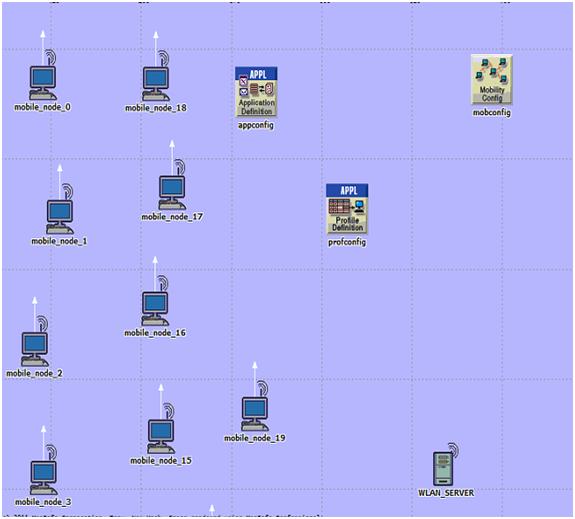Within this first scenario the ADOV protocol is been utilized along with the 20 mobile nodes in order to produce the traffic. The different types of voice applications are used within this scenario in order to identify the service requirements of the quality by using this protocol. The different steps are followed in order to perform this scenario such as follows:
Steps to form basic network
The MANET- mobile Adhoc networks is widely used within this project in order to estimate the entire performance of the AODV protocol which is totally against the different packet losses which needs some important steps to be followed to create the network which is general. A single LAN along with 20 different types of mobile nodes are utilized within the simulation process in order to set the traffic upon the networks. The steps that are to be followed to create the network are explained below:
- Initially the user should open the OPNET modeller simulation tolls and then the user should select the option to open new file in order to start the simulation process
- The project name as well as scenario names should be created in order to obtain the new scenario
- By selecting a specific option users can create the scenario which is employ in which the OPNET modeler can be utilized to load the different types of default scenarios that are totally inherent into the networks.
- In order to select specific type of topology various options have taken place and then alternately in the simulation process the simple campus network is been selected to perform the topology functions
- In the next step the campus size should be situated and then the simulation size of the campus should be set with size of 1000X1000 square meters
- There is a necessity of new network model family for the purpose of simulation of MANET and within the entire available models the appropriate model is selected in order to perform the simulation process. By following the above mentioned steps the basic network which is required to perform the simulation process is explained and then the different objects which are considered from object palette will be utilized in the simulation process in order to get the expected results.
- Depending on the requirement of mobile nodes 20 different types of wireless LAN mobile workstations are utilized which performs an activity as the main source in order to get the final traffic in which the actual real packet analysis process is performed
- The single WLAN server is utilized which acts as an individual application destination along with a server as well as the 20 mobile nodes.
- As discussed earlier the actual aim of this project is to evaluate and estimate the different packet losses towards the Mobile Adhoc networks which requires a traffic and source applications to perform the actions. The configuration is required to the applications in order to produce the traffic that is needed to analyze the entire data packet losses
- The profile definition is been created for the purpose of application which is performed by making use of the profile configuration nodes which are gathered from the object palette.
- The major and important step within the entire simulation process is to set the mobility towards the nodes by making use of the mobile configuration object which is there to perform the process with the object palette and then the finally by following all these steps the first scenario is obtained which is explained in the form of screen shot.
From the above proposed screen it can be identified that the total number of 20mobile nodes starting from mobile_node_0 to mobile_node_19 is been created with the individual WLAN server with different traffic definitions.
In order to set the definitions different types of configurations such as application configuration, mobile configurations as well as the profile configuration are used. The application configuration settings are explained in the further steps.

